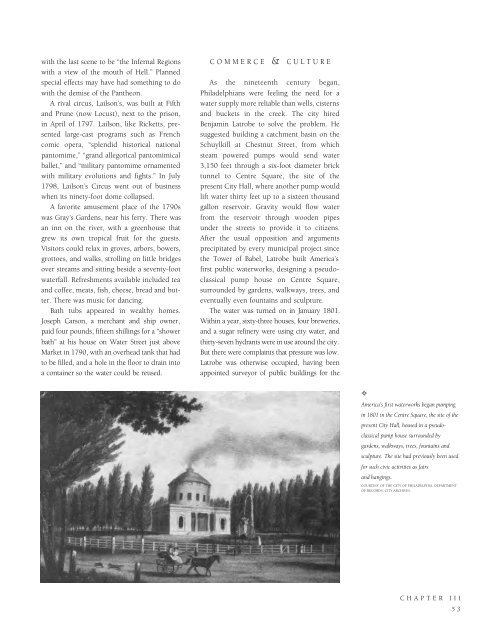Historic Philadelphia
An illustrated history of the city of Philadelphia, paired with the histories of companies, families and organizations that make the region great.
An illustrated history of the city of Philadelphia, paired with the histories of companies, families and organizations that make the region great.
Create successful ePaper yourself
Turn your PDF publications into a flip-book with our unique Google optimized e-Paper software.
with the last scene to be “the Infernal Regions<br />
with a view of the mouth of Hell.” Planned<br />
special effects may have had something to do<br />
with the demise of the Pantheon.<br />
A rival circus, Lailson’s, was built at Fifth<br />
and Prune (now Locust), next to the prison,<br />
in April of 1797. Lailson, like Ricketts, presented<br />
large-cast programs such as French<br />
comic opera, “splendid historical national<br />
pantomime,” “grand allegorical pantomimical<br />
ballet,” and “military pantomime ornamented<br />
with military evolutions and fights.” In July<br />
1798, Lailson’s Circus went out of business<br />
when its ninety-foot dome collapsed.<br />
A favorite amusement place of the 1790s<br />
was Gray’s Gardens, near his ferry. There was<br />
an inn on the river, with a greenhouse that<br />
grew its own tropical fruit for the guests.<br />
Visitors could relax in groves, arbors, bowers,<br />
grottoes, and walks, strolling on little bridges<br />
over streams and sitting beside a seventy-foot<br />
waterfall. Refreshments available included tea<br />
and coffee, meats, fish, cheese, bread and butter.<br />
There was music for dancing.<br />
Bath tubs appeared in wealthy homes.<br />
Joseph Carson, a merchant and ship owner,<br />
paid four pounds, fifteen shillings for a “shower<br />
bath” at his house on Water Street just above<br />
Market in 1790, with an overhead tank that had<br />
to be filled, and a hole in the floor to drain into<br />
a container so the water could be reused.<br />
COMMERCE<br />
& CULTURE<br />
As the nineteenth century began,<br />
<strong>Philadelphia</strong>ns were feeling the need for a<br />
water supply more reliable than wells, cisterns<br />
and buckets in the creek. The city hired<br />
Benjamin Latrobe to solve the problem. He<br />
suggested building a catchment basin on the<br />
Schuylkill at Chestnut Street, from which<br />
steam powered pumps would send water<br />
3,150 feet through a six-foot diameter brick<br />
tunnel to Centre Square, the site of the<br />
present City Hall, where another pump would<br />
lift water thirty feet up to a sixteen thousand<br />
gallon reservoir. Gravity would flow water<br />
from the reservoir through wooden pipes<br />
under the streets to provide it to citizens.<br />
After the usual opposition and arguments<br />
precipitated by every municipal project since<br />
the Tower of Babel, Latrobe built America’s<br />
first public waterworks, designing a pseudoclassical<br />
pump house on Centre Square,<br />
surrounded by gardens, walkways, trees, and<br />
eventually even fountains and sculpture.<br />
The water was turned on in January 1801.<br />
Within a year, sixty-three houses, four breweries,<br />
and a sugar refinery were using city water, and<br />
thirty-seven hydrants were in use around the city.<br />
But there were complaints that pressure was low.<br />
Latrobe was otherwise occupied, having been<br />
appointed surveyor of public buildings for the<br />
✧<br />
America’s first waterworks began pumping<br />
in 1801 in the Centre Square, the site of the<br />
present City Hall, housed in a pseudoclassical<br />
pump house surrounded by<br />
gardens, walkways, trees, fountains and<br />
sculpture. The site had previously been used<br />
for such civic activities as fairs<br />
and hangings.<br />
COURTESY OF THE CITY OF PHILADELPHIA, DEPARTMENT<br />
OF RECORDS, CITY ARCHIVES.<br />
CHAPTER III<br />
53
















